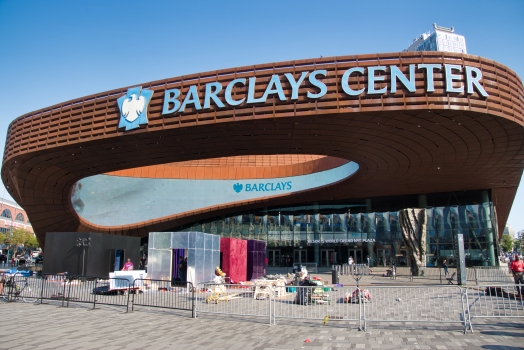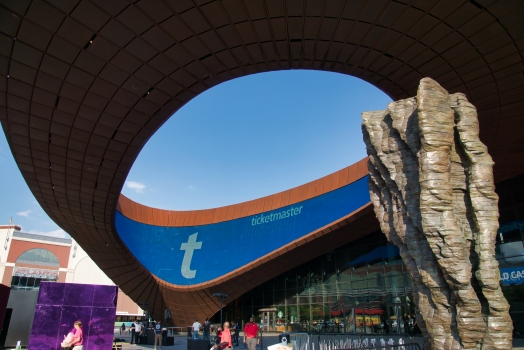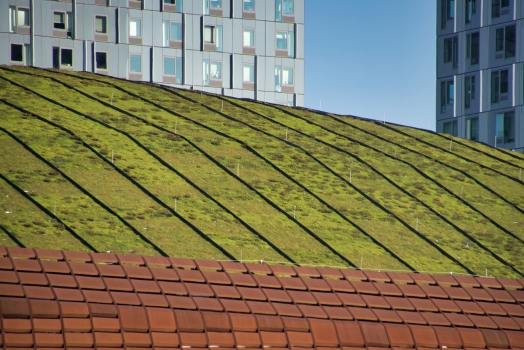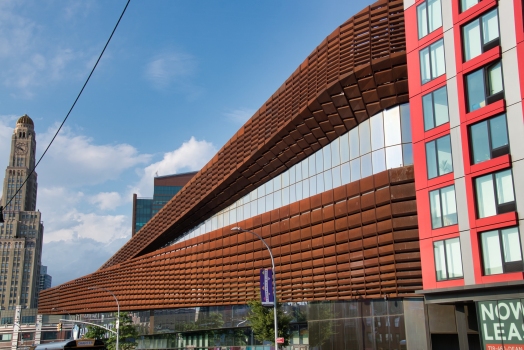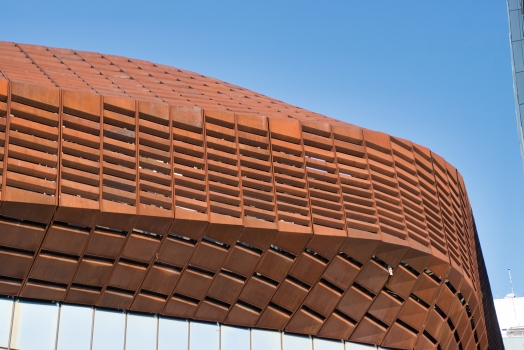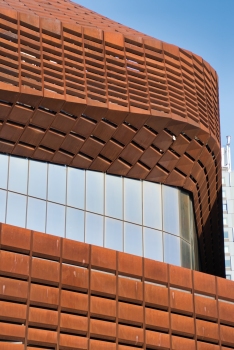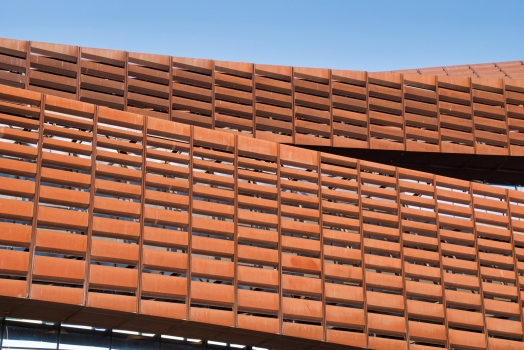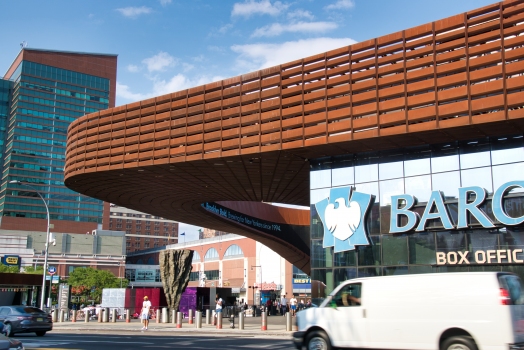General Information
Project Type
| Function / usage: |
Multipurpose hall |
|---|---|
| Material: |
Steel structure |
| Structure: |
roof: Truss |
Location
| Location: |
Brooklyn, New York, New York, USA |
|---|---|
| Address: | 620 Atlantic Avenue |
| Coordinates: | 40° 40' 57.24" N 73° 58' 31.40" W |
Technical Information
Dimensions
| seats | max. 17 732 |
Cost
| cost of construction | ca. United States dollar 1 000 000 000 |
Materials
| roof truss |
steel
|
|---|
Excerpt from Wikipedia
Barclays Center is a multi-purpose indoor arena in the New York City borough of Brooklyn. The arena is home to the Brooklyn Nets of the National Basketball Association, and is also one of the home arenas for the New York Islanders of the National Hockey League (the other is Nassau Coliseum). The arena also hosts concerts, conventions and other sporting and entertainment events. It competes with other facilities in the New York metropolitan area, including Madison Square Garden in Manhattan and Prudential Center in Newark.
The arena is part of a $4.9 billion future business and residential complex now known as Pacific Park. The site is at Atlantic Avenue, next to the renamed Atlantic Avenue–Barclays Center subway station on the 2, 3, 4, 5, B, D, N, Q, R and W routes, as well as directly above the LIRR's Atlantic Terminal.
The arena, proposed in 2004 when real estate developer Bruce Ratner purchased the Nets for $300 million as the first step of the process to build a new home for the team, experienced significant hurdles during its development. Its use of eminent domain and its potential environmental impact brought community resistance, especially as residential buildings and businesses such as the Ward Bakery were to be demolished and large amounts of public subsidies were used, which led to multiple lawsuits. The global recession of 2009 also caused financing for the project to dry up. As a result, construction was delayed until 2010, with no secure funding for the project having been allotted. Groundbreaking for construction occurred on March 11, 2010, and the arena opened on September 21, 2012, which was also attended by some 200 protesters. It held its first event with a Jay-Z concert on September 28, 2012. The arena is owned by the State of New York's Empire State Development authority through a public entity named the Brooklyn Arena Local Development Corporation. It is leased by Brooklyn Event Center LLC, owned by Brooklyn Nets owner Joseph Tsai, with operations (and associated revenue) managed by Tsai's BSE Global.
History
The arena was conceived by Bruce Ratner of real estate developer Forest City Ratner Companies, the New York division of Forest City Enterprises that Ratner founded. He acquired the New Jersey Nets basketball team in 2004 for $300 million (he has since sold most of his shares to continue funding the project) for the purpose of moving them to the Pacific Park development on Brooklyn's Prospect Heights play in the arena that would be the centerpiece of the Pacific Park commercial and residential redevelopment project. The move had marked the return of major league sports to Brooklyn, which had been absent since the departure of the Dodgers to Los Angeles in 1957. Coincidentally, the original proposal for a domed stadium for the Brooklyn Dodgers was just north of the Pacific Park Brooklyn site, where the Atlantic Terminal Mall, also owned by Forest City Ratner Companies, is located.
The arena was initially projected to open in 2006, with the rest of the Pacific Park Brooklyn complex to follow. However, controversies involving local residents, the use of eminent domain, potential environmental impact, lack of continued public financing, as well as a major economic downturn delayed the project. Due to these legal and financial troubles, the development deal seemed headed towards failure or collapse. Frank Gehry, an architect involved in the project's initial designs said, in March 2009, "I don't think it is going to happen," and Ratner at one point explored selling the team. The New York Supreme Court ruled in favor of Ratner on May 16, 2009.[ clarification needed] Opponents appealed the court decision. A hearing for the appeal was scheduled for October 14, 2009, with a decision to be issued no sooner than November 25.
Russian businessman Mikhail Prokhorov agreed to a $200 million deal on September 23, 2009, to become a principal owner of the Nets and a key investor in the Brooklyn arena.
The Nets played two preseason games at Prudential Center in October 2009. The two preseason games were successful, and a deal that would have the Nets play at the Prudential Center for the 2010–11 and 2011–12 NBA seasons became more likely. Negotiations nearly fell apart, when the New Jersey Sports and Exhibition Authority refused to release the Nets from their lease at Izod. Negotiations resumed, and on February 18, 2010, the Nets finalized a deal that would move them to the Prudential Center in Newark, New Jersey until Barclays Center opened.
The New York Court of Appeals ruled in favor of the state using eminent domain for the project on November 24, 2009. Empire State Development Corporation Vice President Warner Johnston indicated that the agency is committed to seeing the project completed and said "we can now move forward with development."
Another potential roadblock to this development resulted from the Appellate Court's negative decision regarding a similar eminent domain case, brought against Columbia University. This landmark case could have given new life to the case being brought by the community group Develop Don't Destroy Brooklyn (DDDB).
However, on March 1, 2010, Brooklyn Supreme Court Justice Abraham Gerges struck down a challenge by property owners, regarding the state's use of eminent domain, which allowed the private property to be condemned. Groundbreaking for the project occurred on March 11, 2010.
The first concrete was poured into Barclays Center's foundation on June 29, 2010. The arena began vertical construction on November 23, 2010, with the erection of the first steel piece. The arena topped out on January 12, 2012, and was opened to the public on September 21, 2012.
Barclays Bank agreed to a 20-year naming rights agreement for $400 million in 2007. However, 2 years later, due to the slump in the economy the deal was renegotiated to $200 million.
The New York Islanders of the National Hockey League (NHL) announced on October 24, 2012, that the franchise would move to Barclays Center in 2015 after the expiration of their lease at the Nassau Veterans Memorial Coliseum, which the team has called home since its inception in 1972. The deal did not require the involvement of the New York Rangers, as the Islanders' agreement with the Rangers to share the New York area allows them to play their home games anywhere on Long Island, including the two city boroughs on the island, Brooklyn and Queens. While Barclays Center was conceived as a multipurpose arena that could accommodate the Nets and an NHL team, it was built mainly for basketball. While it can accommodate an NHL-size rink, the scoreboard was off-centered above the blue line that is closer to the arena's southeast end. Capacity for hockey is 15,795, the second-smallest in the league (behind Winnipeg's Bell MTS Place). The seating arrangement for hockey is asymmetrical. There are only three rows of permanent seating on the northwest end of the arena, and at least 416 seats will not be sold at all due to poor sight lines. As a result of the signing of the lease, the two KHL games scheduled to be played in the arena on January 20 and 21, 2013 between Dynamo Moscow and SKA St. Petersburg were moved back to their teams' home venues. As part of the deal, the management of the Barclays Center took over the business operations of the Islanders when the team moved to Brooklyn, though Charles Wang remained principal owner and continued to oversee hockey operations. This arrangement continued after Wang sold controlling interest in the Islanders to Jon Ledecky and Scott D. Malkin. Business operations were returned to the Islanders following the 2018-19 season, where the franchise now rents the arena and NYCB Live.
According to Billboard Magazine, Barclays Center passed Madison Square Garden as the highest-grossing venue in the US for concerts and family shows, not counting sports events. That statistic was based on ticket sales between November 1, 2012, and May 31, 2013. On February 24, 2015, an ironworker was killed when four joists fell on him as he was helping to install the arena's green roof.
Poor reception of the arena's quality as a hockey venue affected the Islanders' average attendance in comparison to Nassau Coliseum, which fell to an NHL low of 12,059 (the arena itself is also the second-smallest in the league). The team began to seek an exit from Barclays, although NHL officials judged that the Coliseum (even with its recent renovations) would not be suitable as a full-time venue, as it lacked amenities common in new facilities. On June 21, 2018, the Islanders announced that they would begin to play a portion of their home schedule at the Nassau Coliseum until the completion of their new Belmont Park Arena project.
On September 18, 2019 Joe Tsai, through entities controlled by him, completed the acquisition of full ownership of the Brooklyn Nets and Barclays Center. With the closing of the transaction, Tsai became NBA Governor of the Nets and its affiliates and Chairman of Barclays Center . Additionally, on September 18, 2019, leading media and sports executive David Levy was named Chief Executive Officer of the Brooklyn Nets and Barclays Center by Joe Tsai .
Financing
The arena is formally owned by the Brooklyn Arena Local Development Corporation, a public entity. It is leased to private entity Brooklyn Events Center, LLC for $1.00. Being publicly owned, the financing of the stadium was eligible for tax-exempt bonds, which were issued in 2009 for a total of $510,999,996.50.
Design
Barclays Center was designed by the architect firm SHoP Architects. Ellerbe Becket/AECOM served as the project Architect of record.
Initial concepts for the area were designed by Frank Gehry, whose design proposed a rooftop park (open only to residents of the Atlantic Yards complex) ringed by an open-air running track and capable of doubling as an ice skating rink in winter with panoramic, year-round views of Manhattan. The famed architect's tallest tower, called Miss Brooklyn at 620 feet, was also part of this plan. Gehry's plans carried a projected cost of $1 billion. Forest City Ratner unveiled a scaled back version of the project on February 2008 reducing Miss Brooklyn's size 40%, and making it 109 feet shorter. Another redesign unveiled just over two months later scrapped Miss Brooklyn entirely, and in January 2009, the developer started "value engineering" the arena design, cutting its budget even more. In September 2009 the Becket/SHoP proposal with a projected cost (initially) of $800 million (ultimately itself revised to $1 billion) was unveiled.
Externally, the arena's shape features three articulated bands with features a glass curtain wall covered by a "latticework" composed of 12,000 preweathered steel panels engineered and constructed by ASI Limited/SHoP Construction meant to evoke the image of Brooklyn's brownstones. A 117-by-56-foot (36 by 17 m) oculus extends over a 5,660-square-foot (526 m²) section of the plaza outside of the main arena entrance with an irregularly shaped display screen looping the interior face of the oculus. The arena floor's location below grade allows people in the plaza to view the scoreboard.
Inside the arena bowl, there are two sports lighting systems: one for the Nets and one for everyone else. The Nets lighting creates a theater-like effect where the court pops like a stage while the rest of the arena goes dark.
Unlike most other urban venues in the US, Barclays Center has no dedicated parking lot; however, it is easily accessible by subway, bus, and railroad. To accommodate entry to the facility, the arena's 38,885-square-foot (3,613 m²) entrance plaza features a $76 million transit connection hub that serves as the plaza's focal point. The transit structure connects with the refurbished Atlantic Avenue–Barclays Center subway station, whose renovation was designed by New York City firm Stantec.
The original plan promised indoor room for bicycles but the plan was scrapped before the arena's opening with outdoor racks for 400 bicycles, which were eventually taken away. The Empire State Development corporation also promised spots for 550 cars eventually, next to the arena[ where?].
Because of the constrained site, there are only two truck and bus entrances into the building. They consist of two side-by-side 80,000 pounds (36,000 kg) capacity elevators which lower vehicles 35 feet (11 m) below street grade into a loading dock area. Vehicles roll out onto an enormous turntable which rotates them into position opposite one of four loading docks arrayed around the turntable.
Artwork
The building features the mural Diary of Brooklyn by painter José Parlá, which measures 10 feet wide and 70 feet tall. According to Parlá, the painting is all about language; the painting contains words and phrases such as "immigration," "Brooklyn is" and "Big Daddy Kane." The piece was commissioned in 2012 and took six months to complete.
Naming rights
On January 18, 2007, it was announced that the arena would be called Barclays Center, after London-based banking group Barclays. It was reported that the banking and financial services company agreed to pay the team $400 million over the next 20 years for the naming rights of their Brooklyn home, eclipsing the previous record for naming rights to an American indoor arena, set by Royal Philips Electronics in 1999, for $185 million over 20 years for Philips Arena in Atlanta. However, the rights were renegotiated by the end of 2009, and are somewhat more than $200 million. Barclays does not have any retail banks in the US nor does it have its own ATMs in the arena.
Text imported from Wikipedia article "Barclays Center" and modified on October 14, 2019 according to the CC-BY-SA 4.0 International license.
Participants
Relevant Web Sites
- About this
data sheet - Structure-ID
20078554 - Published on:
10/10/2019 - Last updated on:
11/10/2019

